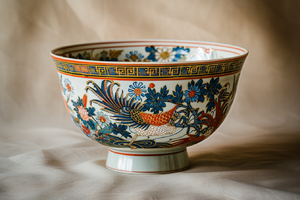Ko-Imari/fa: Difference between revisions
Created page with "کو ایماری" |
Created page with "== پیشینه تاریخی ==" |
||
| Line 4: | Line 4: | ||
[[File:Ko-Imari.png|thumb|Ko-Imari ware from the Edo period]] | [[File:Ko-Imari.png|thumb|Ko-Imari ware from the Edo period]] | ||
«کو-ایماری» (به معنای واقعی کلمه «ایماری قدیمی») به قدیمیترین و نمادینترین سبک ظروف ایماری ژاپنی اشاره دارد که عمدتاً در قرن هفدهم تولید میشدند. این ظروف چینی در شهر آریتا ساخته شده و از بندر ایماری در همان نزدیکی صادر میشدند، که نام خود را از این بندر گرفته است. کو-ایماری به ویژه به دلیل سبک تزئینی پویا و اهمیت تاریخی خود در تجارت جهانی اولیه ظروف چینی قابل توجه است. | |||
< | <span id="Historical_Background"></span> | ||
== | == پیشینه تاریخی == | ||
سفال کو-ایماری در اوایل دوره ادو، حدود دهه ۱۶۴۰، پس از کشف خاک رس چینی در منطقه آریتا پدیدار شد. سفالگران محلی ژاپنی که در ابتدا تحت تأثیر چینی آبی و سفید چینی قرار داشتند، شروع به توسعه هویت سبکی خود کردند. با کاهش صادرات چینی چین به دلیل سقوط سلسله مینگ، چینی ژاپنی شروع به پر کردن شکاف در بازارهای بینالمللی، به ویژه از طریق تجارت با شرکت هند شرقی هلند، کرد. | |||
< | <span id="Key_Features"></span> | ||
== | === ویژگیهای کلیدی === | ||
ویژگیهای متمایز کو-ایماری عبارتند از: | |||
*طرحهای جسورانه و رنگارنگ، معمولاً ترکیبی از زیرلعابی آبی کبالت با لعابهای روی لعاب به رنگهای قرمز، سبز و طلایی. | |||
* | |||
تزئینات متراکم و متقارن که تقریباً تمام سطح را میپوشاند، اغلب به عنوان تزئینات غنی یا حتی مجلل توصیف میشود. | |||
نقوشهایی مانند گل داوودی، گل صد تومانی، ققنوس، اژدها و امواج یا ابرهای سبکسازی شده. | |||
بدنه چینی ضخیم در مقایسه با قطعات بعدی و ظریفتر. | |||
ظروف کو-ایماری صرفاً برای مصارف خانگی در نظر گرفته نشده بودند. بسیاری از قطعات متناسب با سلیقه اروپاییها ساخته میشدند، از جمله بشقابهای بزرگ، گلدانها و تزئینات تزئینی برای نمایش. | |||
<div lang="en" dir="ltr" class="mw-content-ltr"> | <div lang="en" dir="ltr" class="mw-content-ltr"> | ||
Revision as of 04:42, 18 July 2025
Ko-Imari

«کو-ایماری» (به معنای واقعی کلمه «ایماری قدیمی») به قدیمیترین و نمادینترین سبک ظروف ایماری ژاپنی اشاره دارد که عمدتاً در قرن هفدهم تولید میشدند. این ظروف چینی در شهر آریتا ساخته شده و از بندر ایماری در همان نزدیکی صادر میشدند، که نام خود را از این بندر گرفته است. کو-ایماری به ویژه به دلیل سبک تزئینی پویا و اهمیت تاریخی خود در تجارت جهانی اولیه ظروف چینی قابل توجه است.
پیشینه تاریخی
سفال کو-ایماری در اوایل دوره ادو، حدود دهه ۱۶۴۰، پس از کشف خاک رس چینی در منطقه آریتا پدیدار شد. سفالگران محلی ژاپنی که در ابتدا تحت تأثیر چینی آبی و سفید چینی قرار داشتند، شروع به توسعه هویت سبکی خود کردند. با کاهش صادرات چینی چین به دلیل سقوط سلسله مینگ، چینی ژاپنی شروع به پر کردن شکاف در بازارهای بینالمللی، به ویژه از طریق تجارت با شرکت هند شرقی هلند، کرد.
ویژگیهای کلیدی
ویژگیهای متمایز کو-ایماری عبارتند از:
- طرحهای جسورانه و رنگارنگ، معمولاً ترکیبی از زیرلعابی آبی کبالت با لعابهای روی لعاب به رنگهای قرمز، سبز و طلایی.
تزئینات متراکم و متقارن که تقریباً تمام سطح را میپوشاند، اغلب به عنوان تزئینات غنی یا حتی مجلل توصیف میشود.
نقوشهایی مانند گل داوودی، گل صد تومانی، ققنوس، اژدها و امواج یا ابرهای سبکسازی شده.
بدنه چینی ضخیم در مقایسه با قطعات بعدی و ظریفتر.
ظروف کو-ایماری صرفاً برای مصارف خانگی در نظر گرفته نشده بودند. بسیاری از قطعات متناسب با سلیقه اروپاییها ساخته میشدند، از جمله بشقابهای بزرگ، گلدانها و تزئینات تزئینی برای نمایش.
Export and European Reception
Ko-Imari ware was exported in large quantities throughout the 17th and early 18th centuries. It became a fashionable luxury item among European elites. In palaces and aristocratic homes across Europe, Ko-Imari porcelain adorned mantelpieces, cabinets, and tables. European porcelain manufacturers, particularly in Meissen and Chantilly, began producing their own versions inspired by Ko-Imari designs.
Evolution and Transition
By the early 18th century, the style of Imari ware began to evolve. Japanese potters developed more refined techniques, and new styles such as Nabeshima ware emerged, focusing on elegance and restraint. The term Ko-Imari is now used to specifically distinguish these early exported works from later domestic or revival pieces.
Legacy
Ko-Imari remains highly valued by collectors and museums worldwide. It is considered a symbol of Japan’s early contribution to global ceramics and a masterwork of Edo-period craftsmanship. The vivid designs and technical achievements of Ko-Imari continue to inspire both traditional and contemporary Japanese ceramic artists.
Relationship to Imari Ware
While all Ko-Imari ware is part of the broader category of Imari ware, not all Imari ware is considered Ko-Imari. The distinction lies primarily in the age, style, and purpose. Ko-Imari specifically refers to the earliest period, characterized by its dynamic energy, export orientation, and richly decorated surfaces.
